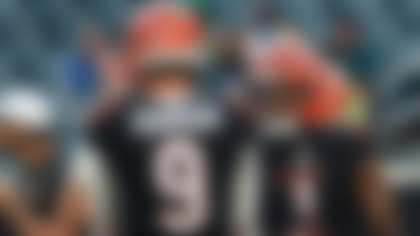When I was initially asked to identify underperforming units a couple of years ago, I started by creating a new model to measure performance that was more subjective than my normal models based specifically on game output. I used clues about offseason free-agent signings, salaries, preseason projections and when players were drafted -- and then adjusted for major injuries over the course of the season in order to calibrate expectations.
In last year's file, driven by the desire to incorporate as many "outsider" data points as possible, I also factored in my win-share model. (Reminder: My win-share figure is defined as the measurement of how each player, position group and side of the ball impacts a team's ability to earn first downs and touchdowns, as related to wins. And yes, these can be negative.)
The whole point is to apply structure in an unbiased way in order to contextualize football and take into account the situations that lead to specific outcomes -- and then, in this case, to relate them back to expectations. (I rank each team's position groups ahead of the season using projected win share.) That last part really matters, because this analysis is intended to talk about underperformance in context. For example, Seattle acquiring a big-ticket trade piece like Carlos Dunlap at midseason invalidates the Seahawks' preseason ranking. It's all about using a strategic lens.
This season, I've shifted from looking at 10 underperforming units to five that underperformed and five that overperformed, because we all need a little more positivity in our lives at this juncture. The areas my model flagged for negative impact were compared to areas of high preseason expectations and/or disproportionate negative win share. The areas my model flagged for positive impact exceeded their preseason expectations and/or disproportionate positive win share.
So, without further ado, let's get to the meat of this file: The five most overperforming and underperforming units of 2020. Obviously, these all could be big factors in 2021 offseason approaches, decisions and strategies.
OVERPERFORMERS
Ahead of the season, my models forecasted Cleveland's O-line to be the 11th-best in the league. But the Browns ended up boasting my top-rated line by win share. Pro Football Focus also ranked the unit first, following a No. 23 ranking in 2019. My computer-vision measurements show that on play-action passes, the line was not penetrated or pushed back for 0.22 seconds longer than any other line. (Think of 2.5 seconds as a long time in this context, so this is like 10 percent of that.)
This is definitely a James Robinson tribute segment. The undrafted rookie from Illinois State nearly single-handedly took a backfield my forecast slated to rank 30th all the way to 20th. Next Gen Stats show that Robinson ranked 22nd in the NFL in rushing yards over expected with 41 (minimum of 100 rushes). The preseason ranking of 30th reflected the release of Leonard Fournette, who earned 120 such rushing yards in 2019. Robinson projects for big things next season, and one of the ways to show what his best looks like is how he handled light boxes this year. NGS shows he averaged 6.0 yards per rush (574 yards on 95 attempts), which was the fifth-best rate among running backs against light boxes.
I definitely came into this season with serious concerns about the Bucs' running game. I really thought it could be the Achilles' heel for this offense, with my No. 28 preseason ranking for Tampa's ground attack. Obviously, that was wrong. Ronald Jones led all qualified running backs in averaging 7.2 yards per rush inside the tackles with seven or fewer defenders in the box (69 rushes for 500 yards, per Next Gen Stats). He also earned 219 rushing yards over expected, ranking fifth-best in the NFL. The addition of first-round tackle Tristan Wirfs to Tampa's line netted dividends that immediately outpaced my projections and helped create a more optimal situation for the entire offense to operate.
Remember: This refers to the position group as a whole, because I certainly did not think Davante Adams would disappoint ahead of the season. I did, however, rank Green Bay's receiving corps 19th in the preseason by projected win share. Lack of depth is typically a very difficult issue to weather and makes it harder for the star to overcome the extra attention he's given. But again, this was not the case. Between Aaron Rodgers, the scheme and the balanced attack, this unit is not the reason the Packers won't be playing in Tampa on Super Bowl Sunday. Overall, Green Bay's wideouts caught 78.6 percent of targets down the seams this season, which is the best rate in the NFL (per NGS), with 10 TDs and three interceptions. Packers receivers also led the league when facing press coverage (less than a 3-yard cushion), hauling in 68.4 percent of targets with 14 touchdowns (most in the NFL) and only two picks.
Complementary football, when it comes to the explosive Chiefs, means that Kansas City's defense must excel on passing downs. Because most opponents are forced to air it out in order to keep up -- or catch up -- with Patrick Mahomes and Co. While my preseason rankings liked K.C.'s safeties (10th), the team's corners projected to rank 22nd. The whole group of defensive backs ended up exceeding expectations. Next Gen Stats show that the Chiefs allowed a 60.3 completion percentage to slot targets and a 41.9 completion percentage on passes of 10-plus air yards, the second-best rate in the NFL on both fronts. Kansas City netted 12 interceptions against 13 touchdowns on passes of 10-plus air yards, with that INT figure tied for second-most. One big factor in Kansas City's unexpected success in the defensive backfield: fourth-round rookie L'Jarius Sneed has proven to be an absolute draft steal.
UNDERPERFORMERS
Certainly not a typical year from a Mike Zimmer-led defense. Even taking into account the key departures ahead of the season and all the D-line shuffling during the year, it's pretty shocking that the Vikings ended up with just 23 sacks (ranking 28th) -- with only five total in Weeks 11 through 17 -- and the 31st-ranked pressure percentage (19.9, per NGS). One thing to note: The Vikings made a whopping 15 picks in the 2020 NFL Draft, including multiple defensive linemen. Obviously, these rookies didn't enjoy the benefit of a normal offseason or preseason ramp-up. So, you could see how this would significantly hamper the 2020 Vikings. They could be due for a big developmental jump in 2021.
Traditional stats show that Ravens wideouts earned the fewest total receiving yards (1,729) of any NFL group this season. Pro Football Focus ranked Baltimore's receivers 29th overall, while my models show that the unit's total win share sat at 30th. Of course, there's additional context here, including the fact that star tight end Mark Andrews was injured for part of the season, which affected how opponents covered Ravens wideouts. But the receivers' off-ball metric (which measures how WRs spread opposing defenses and create space for other pass catchers or the run game) was the worst in the NFL. In other words, pass-catching inefficiencies at WR even hindered the ground attack.
Injuries always matter, but this was a dramatic decline. Ahead of the season, my model projected this line to rank second-best in the NFL and be a main reason why the Cowboys would win the NFC East. In the end, Dallas' front five ranked 29th in my model. Pro Football Focus ranked the Cowboys at 27th on the OL, with only the Dolphins, Jets, Bengals, Giants and Chargers below.
Ahead of the season, I had the Eagles' quarterback position -- the whole QB room -- ranked 17th. To come up with my rankings, backup QBs are valued, as well (they account for approximately 20 percent of the win share). So Carson Wentz alone was No. 14. And obviously, we had zero NFL data at that point on second-round pick Jalen Hurts. Philadelphia's offensive line and receivers were extremely banged up all season long, which did have a negative impact, but Next Gen Stats show that Wentz took 40 sacks with a time to throw of four-plus seconds, the most in the NFL. These extended dropbacks are somewhat of a proxy for "holding on to the ball too long." On these plays, Wentz went 21-for-57 -- a lowly 36.8 completion percentage -- while averaging just 5.1 yards per attempt with a 3:4 touchdown-to-interception ratio. This all shows that, between sacks and interceptions, there is a lot of room for improvement from the Eagles' quarterback position.
The Titans recorded just 19 sacks this season (30th in the NFL), with only five total between weeks 10 and 16 (the fewest in the league in that span). It is worth noting that they had four in Week 17 when facing Deshaun Watson. Overall, Tennessee's 20.5 pressure percentage this season ranked 30th by Next Gen Stats' count. While pressure percentage alone doesn't always tell the full story, that was an uncharacteristically low mark from a team known for fielding multiple, confusing-for-offenses, disguised fronts that typically create run stops and pressures with ease. Look for this to be an area of focus in free agency and/or the draft.
Follow Cynthia Frelund on Twitter.






















